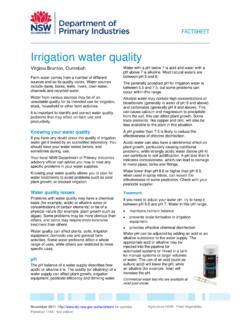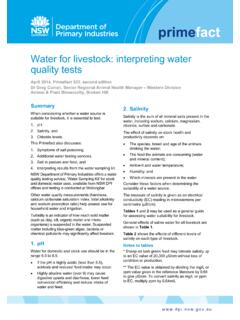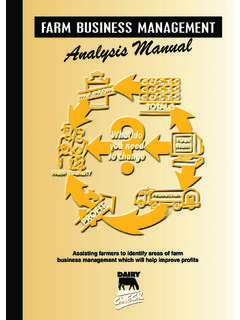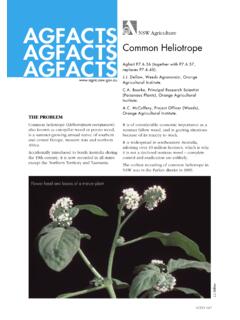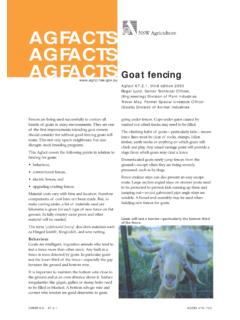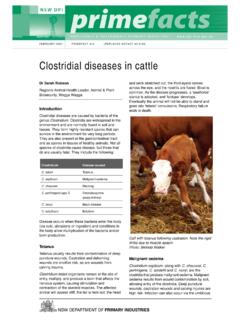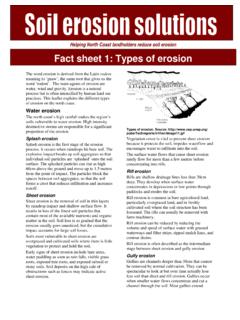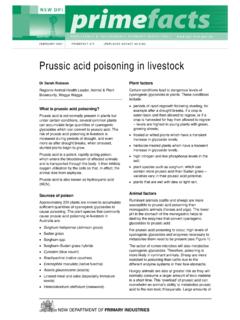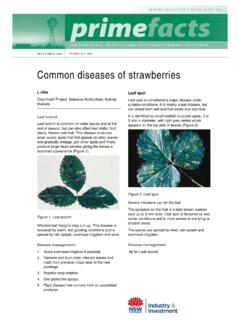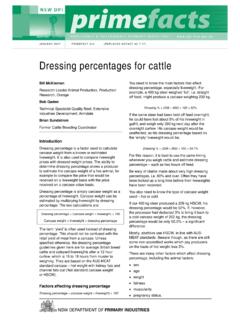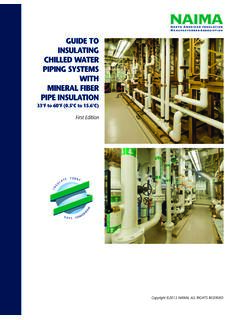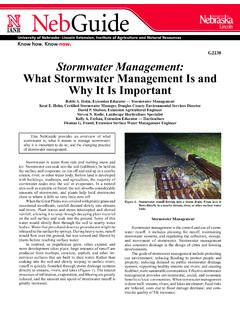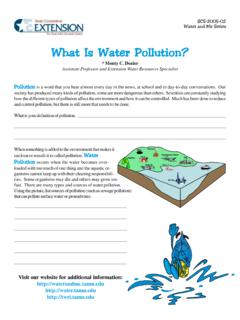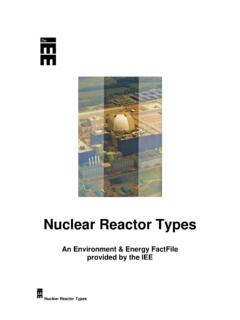Transcription of Interpreting water quality test results
1 Interpreting water quality test resultsNovember 2016 Primefact 1344 first edition NSW DPI Agriculture water Unit water quality is a key issue for farmers, and the DPI Agriculture water and Irrigation Unit has produced this summary on Interpreting water quality test results for: pH alkalinity hardness saturation Index (SI) electrical conductivity (EC) sodium adsorption ratio (SAR) chloride. pH The test for pH measures the balance between positive hydrogen ions (H+) and negative hydroxyl ions (OH ). This indicates if water is alkaline (pH >7), neutral (7) or acid (<7).
2 Irrigation: pH to is suitable for most plants. Household: pH to is suitable for domestic use If pH >8, calcium in soil can precipitate (e xchangeable sodium percentage (ESP) increases) and can block equipment (refer to the SAR section). If pH <6, corrosion of metal pipes and fittings can start. If pH <4, water can contribute to soil acidity. If pH > or <6, spray mixes can be affected. Alkalinity Alkalinity is a quantitative measure of the total or potential hydroxyl (OH ) ions. It is mainly caused by the presence of bicarbonates (HCO3 ) and carbonates (CO32 ) in water .
3 It is measured as mg/L CaCO3 equivalent. It should not be confused with the measurement of pH described above. As bicarbonates are usually the main contributor to alkalinity, high levels can cause soil problems by increasing soil sodicity (see the section on SAR, below). Levels of alkalinity that can cause problems are: <90 mg/L low risk of problems occurring 90 335 mg/L moderate risk of soil problems (declining soil structure) and reduced plant growth from prolonged use, and accumulation of a white scale on plants spray-irrigated in high humidity weather >335 mg/L high risk of soil problems and reduced plant growth, and a build-up of scale, which blocks metal pipes Interpreting water quality test results 2 NSW Department of Primary Industries, January 2017 >500 mg/L can be harmful to human health, but water develops an unpleasant taste well before this level.
4 Hardness Hardness means the concentration of all the metallic cations in water . In practice, it is a measure of the dissolved calcium and magnesium salts, and is also expressed as mg/L CaCO3 equivalent. Hard water affects the behaviour of domestic water , as it precipitates fatty acids, causing formations of scums, yellowing of clothes and making it difficult to lather soap. It also causes encrustations that can block hot water systems, metal pipes and irrigation fittings, and can reduce soil structure. water with less than 100 mg/L CaCO3 is generally regarded as suitable for most uses.
5 Suggested hardness limits are: 150 mg/L: hot water systems and dairy equipment 200 mg/L: other domestic use 300 mg/L: for mixing chemical sprays and dips, and can have adverse effect on soil structure >500 mg/L: limit for most other uses. SI The saturation index (SI) of water is a relationship between pH, salinity, alkalinity and hardness. It assesses the potential of the water to cause scaling and precipitation (positive number) or corrosion (negative number). If SI is between and + , there is little likelihood of scaling or corrosion.
6 If SI is between + and + , there is moderate risk of scaling. If SI is > + , there is strong risk of scaling. If SI is between and , there is moderate risk of corrosion. If SI is < there is strong risk of corrosion. EC EC refers to the electrical conductivity of water or the soil solution, and measures the concentration of ions (positively charged cations and negatively charged anions) that make up salts. ECw is the salinity of water , the common unit of measurement being decisiemens per metre (dS/m). Other units of measurement and conversions are: 1 dS/m = 1000 EC units (or mS/cm) = approx.
7 640 mg/L (or ppm) Plants differ in their tolerance of salinity in the soil, and the soil s internal drainage also influence tolerance levels. As a general guide, the water salinity (ECw) limits for a range of uses, including minimal (<10%) yield reductions in moderate to slow draining soils*, are as follows: dS/m: salinity sensitive plants, including white clover (New Zealand), field beans and strawberry dS/m: red clover, grape, almond and plum dS/m: lucerne (most varieties) dS/m : drinking water (based on taste considerations) dS/m : absolute limit for people dS/m : phalaris, fig dS/m : dairy cattle dS/m.
8 Wheat, millet, buffel grass (Nunban variety) dS/m : mixing herbicides dS/m : any irrigation (leave it in the ground) Interpreting water quality test results 3 NSW Department of Primary Industries, January 2017 dS/m : beef cattle, horses. * Limits for plants are slightly higher in fast draining, sandy soils, but in heavy clays the limits are half the values given here. See the Primefact 1345 Salinity tolerance in irrigated crops for salinity tolerance levels for a range of agricultural and ornamental plants in different soils.
9 If ECw is more than 1 dS/m, seek advice from DPI Agriculture or Local Land Services offices in your region. SAR SAR is the sodium adsorption ratio, which indicates a possible sodium hazard. It relates the amount of sodium relative to calcium and magnesium in water . When the SAR is >3, the water is sodic, and can increase the exchangeable sodium percentage (ESP) of the soil. When the ESP of a soil is >6 per cent, it is likely to adversely affect soil structure and the soil is likely to disperse, causing reduced infiltration, percolation and drainage, cloddy seedbeds and poor seedling emergence if the surface becomes crusted and seals.
10 The adverse impact of sodicity in water is related to its salinity. There is a risk of both reduced infiltration and declining soil structure if the water has moderate to high SAR, but low salinity (ECw). There will be no reduction in the rate of water infiltration with moderate to high salinity (ECw), regardless of whether the SAR is high or low, but the sodicity hazard remains. The main danger regarding water penetration is when soil sodicity increases due to using sodic water , and the soil disperses in a wet year or when fresh channel water is used.
